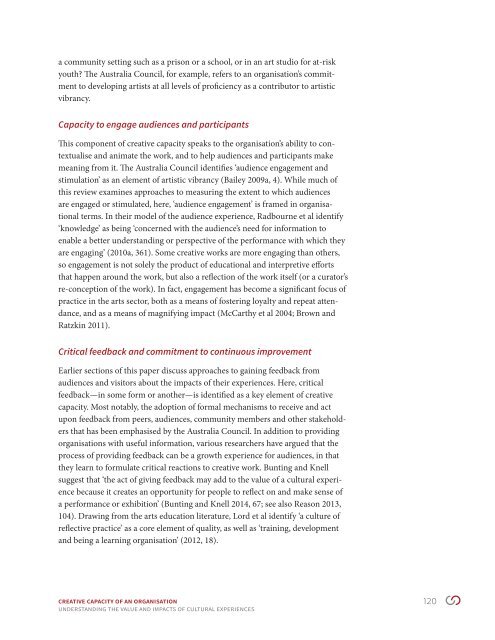aceUVi
aceUVi
aceUVi
Create successful ePaper yourself
Turn your PDF publications into a flip-book with our unique Google optimized e-Paper software.
a community setting such as a prison or a school, or in an art studio for at-risk<br />
youth The Australia Council, for example, refers to an organisation’s commitment<br />
to developing artists at all levels of proficiency as a contributor to artistic<br />
vibrancy.<br />
Capacity to engage audiences and participants<br />
This component of creative capacity speaks to the organisation’s ability to contextualise<br />
and animate the work, and to help audiences and participants make<br />
meaning from it. The Australia Council identifies ‘audience engagement and<br />
stimulation’ as an element of artistic vibrancy (Bailey 2009a, 4). While much of<br />
this review examines approaches to measuring the extent to which audiences<br />
are engaged or stimulated, here, ‘audience engagement’ is framed in organisational<br />
terms. In their model of the audience experience, Radbourne et al identify<br />
‘knowledge’ as being ‘concerned with the audience’s need for information to<br />
enable a better understanding or perspective of the performance with which they<br />
are engaging’ (2010a, 361). Some creative works are more engaging than others,<br />
so engagement is not solely the product of educational and interpretive efforts<br />
that happen around the work, but also a reflection of the work itself (or a curator’s<br />
re-conception of the work). In fact, engagement has become a significant focus of<br />
practice in the arts sector, both as a means of fostering loyalty and repeat attendance,<br />
and as a means of magnifying impact (McCarthy et al 2004; Brown and<br />
Ratzkin 2011).<br />
Critical feedback and commitment to continuous improvement<br />
Earlier sections of this paper discuss approaches to gaining feedback from<br />
audiences and visitors about the impacts of their experiences. Here, critical<br />
feedback—in some form or another—is identified as a key element of creative<br />
capacity. Most notably, the adoption of formal mechanisms to receive and act<br />
upon feedback from peers, audiences, community members and other stakeholders<br />
that has been emphasised by the Australia Council. In addition to providing<br />
organisations with useful information, various researchers have argued that the<br />
process of providing feedback can be a growth experience for audiences, in that<br />
they learn to formulate critical reactions to creative work. Bunting and Knell<br />
suggest that ‘the act of giving feedback may add to the value of a cultural experience<br />
because it creates an opportunity for people to reflect on and make sense of<br />
a performance or exhibition’ (Bunting and Knell 2014, 67; see also Reason 2013,<br />
104). Drawing from the arts education literature, Lord et al identify ‘a culture of<br />
reflective practice’ as a core element of quality, as well as ‘training, development<br />
and being a learning organisation’ (2012, 18).<br />
CREATIVE CAPACITY OF AN ORGANISATION 120<br />
UNDERSTANDING the value and impacts of cultural experiences


